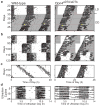Melanopsin cells are the principal conduits for rod-cone input to non-image-forming vision
- PMID: 18432195
- PMCID: PMC2871301
- DOI: 10.1038/nature06829
Melanopsin cells are the principal conduits for rod-cone input to non-image-forming vision
Abstract
Rod and cone photoreceptors detect light and relay this information through a multisynaptic pathway to the brain by means of retinal ganglion cells (RGCs). These retinal outputs support not only pattern vision but also non-image-forming (NIF) functions, which include circadian photoentrainment and pupillary light reflex (PLR). In mammals, NIF functions are mediated by rods, cones and the melanopsin-containing intrinsically photosensitive retinal ganglion cells (ipRGCs). Rod-cone photoreceptors and ipRGCs are complementary in signalling light intensity for NIF functions. The ipRGCs, in addition to being directly photosensitive, also receive synaptic input from rod-cone networks. To determine how the ipRGCs relay rod-cone light information for both image-forming and non-image-forming functions, we genetically ablated ipRGCs in mice. Here we show that animals lacking ipRGCs retain pattern vision but have deficits in both PLR and circadian photoentrainment that are more extensive than those observed in melanopsin knockouts. The defects in PLR and photoentrainment resemble those observed in animals that lack phototransduction in all three photoreceptor classes. These results indicate that light signals for irradiance detection are dissociated from pattern vision at the retinal ganglion cell level, and animals that cannot detect light for NIF functions are still capable of image formation.
Figures




References
-
- Hubel DH. Eye, brain, and vision (Scientific American Library) W.H. Freeman; New York: 1988.
-
- Berson DM, Dunn FA, Takao M. Phototransduction by retinal ganglion cells that set the circadian clock. Science. 2002;295:1070–3. - PubMed
-
- Freedman MS, et al. Regulation of mammalian circadian behavior by non-rod, non-cone, ocular photoreceptors. Science. 1999;284:502–4. - PubMed
-
- Czeisler CA, et al. Suppression of melatonin secretion in some blind patients by exposure to bright light. N Engl J Med. 1995;332:6–11. - PubMed
MeSH terms
Substances
Grants and funding
LinkOut - more resources
Full Text Sources
Other Literature Sources
Molecular Biology Databases
Research Materials

